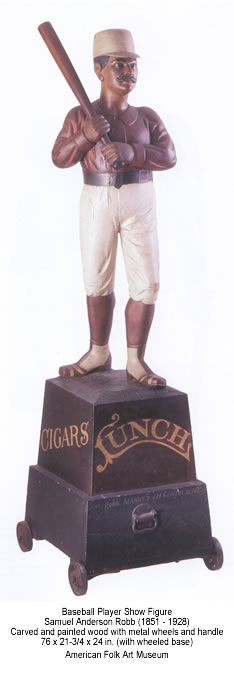American Folk Art Museum Looks at Baseball
When a great baseball player like George Herman Ruth, Ted Williams or Willie Mays retires, the team or teams to which they are most strongly associated usually retire their jersey number as well. No Yankee will ever wear the number "3" again. It belongs to the Babe.
Webster Dictionary defines a "pastime" as "something that amuses and serves to make time pass agreeably." For me, the word invokes a sense of history, as in "past time" or time that has "long since passed." Pastime is a serviceable word. Still, I cannot recall newspapers, magazines, novelists or people in their day-to-day conversations employing the expression except in one context. It's almost as if the word "pastime," like a hall of fame ball-player's retired jersey, has been permanently set aside to be used in that one single phrase where it resonates so perfectly.
If you have an interest in baseball or American folk art, you might consider an excursion to 45 West 53rd street. The newly opened American Folk Art Museum is running a show called, "The Perfect Game – America Looks at Baseball. The exhibition (running until Feb. 1, 2004) includes baseball: trade figures, prints, weathervanes, signs, arcade toys, presentation bats, andirons and textiles like tiny samplers and magnificent quilts, all with baseball themes. Early baseball tobacco cards and scorecards are also exhibited as well as a collection of "outsider art" baseball paintings.
"Outsider Art "is 20th century art of such an amateurish nature it looks as if it was rendered by 5th grade finger-painting students who preferred gym class to art class. Problem is, the paintings were executed by grown up adults who are now worshiped by other grown ups (most rich artsy types) who should know better. With the exception of a few inspired works like Sam Doyle's (1906-1985) "Jackie Robinson Stealing Home" the outsider art is only part of the show that isn't timeless and spectacular from an antique, art and historical standpoint.
When I visited the show a few weeks ago, I asked the girl in the coat and package check area what article seemed to be generating the most enthusiasm. Coat check attendants are frequently the best informed. "That's easy," she said. "It's the Yankee needlework pictures!" Artist Ray Materson began working on the app. 2.5" square miniature tapestries to pass the time while serving a prison sentence for armed robbery. Using materials available to him like unraveled socks, shoelace threads and boxer shorts - used as the backing - Materson depicted Mickey Mantle, Whitey Ford, Roger Maris and other players from the great 1963 Yankee team with such amazing skill that they look like colorful baseball cards from a distance and are even more beautiful and awe-inspiring up close. Averaging 1200 stitches per square inch in his pictures, I came away with the impression Materson must have been reliving his boyhood and the '63 season all over again as he worked away on his tiny masterpieces.
A few of my favorite pieces in the exhibit include:
- A "Baseball Player Show Figure" signed by renowned cigar store Indian carver, Samuel Robb (NY, 1851-1928). The carved and painted wood figure looks like a 6.5' masterful tobacco figure except that the figure is a fully outfitted baseball player with handlebar mustache posing with a baseball bat in his hands. The wheeled base on which the proud ballplayer stands has the words, "Cigars" and "Lunch" painted on its sides. American folk art gets no better.
- "Union Prisoners at Salisbury, N.C." is a framed large size 1863 colored stone lithograph depicting soldiers (many in uniform dress) and slaves playing what must be one of the first organized baseball games at a Confederate prison camp. Talk about cross collectibility!
- Housed in 12-part Victorian frame, "Twelve Early Baseball Images" features eleven 3" by 2" tintype photos and one "carte de visite" (paper photo) of boys and men holding baseball bats, gloves and balls. Some are in uniform. When it comes to old photographs, like many other categories of antiques, subject matter is the biggest determinant of antique value. One of the images shows a girl in a dress standing next to her little brother who was smiling in his baseball uniform. My take was that the little girl dreamed of playing ball just like her brother. However, in those days girls didn't play baseball or participate in boy's sports games. Glad for the change.
- "Woman's Hair Comb with Baseball Motif" features a circa 1870, large, elaborate carved-horn hair comb typical of the Victorian Era. Most were executed in tortoise shell. Amazingly, the artist concealed four fully uniformed baseball figures within his or her elaborate network of scrolls and fauna designs on the comb handle. Having overlooked the article at first, I am going to take a much closer look at carved hair combs and other such antiques in the future!
"Baseball Batter Weathervane" is a sheet metal wrought vane made in the U.S. from 1930 – 1940. The striking silhouette image is of a batter swinging a huge bat through the strike zone. His right leg is anchored. His head angle seems to be bearing down so that he can see exactly where the ball and bat are meeting in terrific impact. The cover piece of the show is also the most instructive. Visual effect and interesting subject matter are the cores of American folk art. A weathervane that legally isn't even an antique according to many definitions is the premier article of the show - as it should be. The artist who wrought it really understood the game. Experienced the smell of the leather glove. Felt that springtime zest boys have been experiencing for over 150 years. The wind-vane maker left us a stunning example that contributes to the baseball's standing as America's national "pastime."

